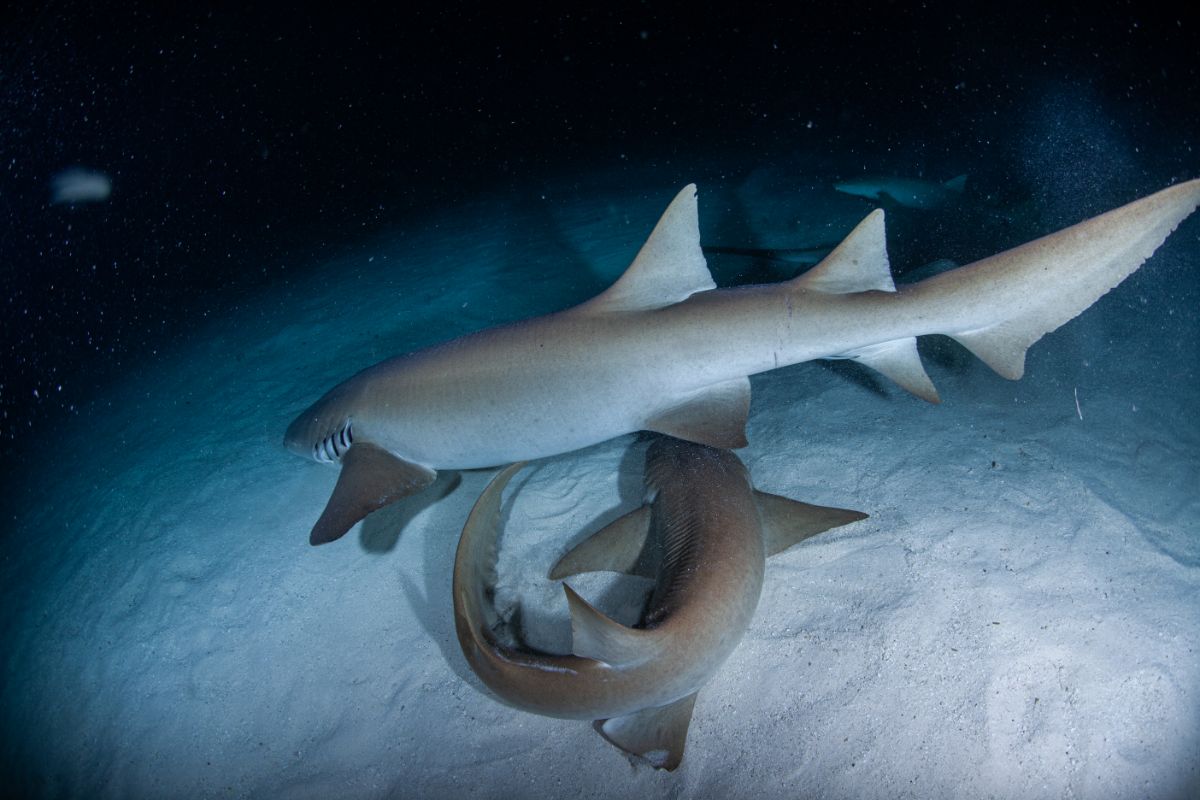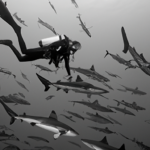How sharks mate is actually a fascinating process, especially when compared to other fish species.

Rather than releasing gametes (reproductive cells) into the water to create fertilized eggs and larvae, sharks have internal fertilization like mammals.
This begs the question, how do sharks mate like mammals when underwater?
The short answer is that it’s not an easy process, but we’re going to explore the subject below!
How Do Sharks Mate? An Overview
When a female shark is ready to mate she releases pheromones, which are chemical signals that let any surrounding males know she is ready to mate.
The interested male will then bite her back, fins, and flank in order to get the male into a position where he can successfully mate with her.
Due to this vicious mating process, the skin of female’s sharks has evolved to be almost twice as tough as male’s skin.
The male shark inseminates the female with a clasper.
This is much like a penis, and is an external appendage that is often found on creatures like chimaeras, skates, and stingrays and its purpose is to insert sperm into the cloaca of a female.
But unlike penises found on other animals, it is not an appendage on its own but extends from the pelvic fin.
The male shark doesn’t use all his sperm at once, and in fact, female Brownbanded Bamboo Sharks can save sperm for use in the future.
In fact, a captive Brownbanded Bamboo Shark in California birthed a pup despite not having mated with a male for 3.5 years.
Also, some female sharks mate with multiple sharks, and use different sperm to fertilize their eggs.
This means that the same litter of pups may not have the same father!
Once an egg is fertilized, the organs of the embryo will begin to develop.
The growing embryo will receive nutrients in a few different ways.
An embryo that receives nutrients from the yolk are lecithotrophic, while embryos receive nutrients from the yolk and their mother are called matrotrophic embryos.
The latter is quite similar to elasmobranch species like stingrays, who receive nutrients from the yolk but then start to receive uterine milk that is produced by their mothers at later stages of development.
Shark Life Cycle & Parenting
Sharks mature slowly, and take longer to mature than most other animals.
Their young are called pups, and a female shark will give birth to a relatively low amount of pups throughout their life. Despite this, pups have a rather high chance of making it to adulthood.
Their pregnancies also last a pretty long time. A female shark can be pregnant for 9 to 12 months, and some species can have gestation periods that last for several years.
Similarly to other animal species, a lot of shark species do not give birth every year, and like to take some rest between their litters.
However, while this isn’t uncommon in other animal species, sharks do take this approach to mating very differently.
Whereas a lot of animals – mammals in particular – have powerful parental instincts that include nurturing their young and protecting them at all costs, sharks do not possess these instincts.
Once a shark pup is born, it’s out in the world all on its own, which makes their high survival rate even more impressive!
What Are Shark Nurseries?

To increase the chances of their pups saving, some sharks will lay their eggs, or give birth, in nurseries.
The main criteria of shark nurseries is that they have to be in a secluded, safe area like a mangrove.
Shark nurseries often have shallow, warm water with good supply of food and a low amount of predators.
In a shark nursery, young sharks can perfect their hunting skills without worrying about being prey for other predators.
When the young sharks are big enough they will then leave the nursery.
What Is Viviparity?
There are two kinds of viviparous sharks. These are placental (these are sharks that have a placenta), and aplacental (sharks that don’t have a placenta).
Placental Viviparity
Viviparous sharks that have a placenta, such as Bonnethead Sharks, produce offspring in a very similar way to mammals.
Their pups feed on the placenta up until birth. Their umbilical cord provides oxygen and nutrients from their mother’s bloodstream and can be found between the pectoral fin.
This actually leaves them with a small navel when they’re born, but this heals rather quickly.
When the time comes for the pup to be born, it will move into the cloacal chamber and then through the cloaca into the ocean.
Pups tend to be born tail first, although there are some that come out head first like mammal babies do.
Aplacental Viviparity
Aplacental viviparity is also referred to as ‘ovoviviparity’ and is a type of reproduction that is common in elasmobranchs, like eagle rays.
This is where an animal will produce eggs without laying them. Rather, the eggs will develop and then hatch inside the mother.
This is a method of reproducing that is found in fish and insects, and reptiles like species of snakes and lizards.
These eggs have thinner cases than the egg cases of oviparous sharks and while inside the mother’s uterus they remain fragile.
These embryos don’t have a placental connection and do not receive nutrients from their mother.
Rather, they receive nutrients from their yolk supply.
Once the time comes for the pup to be born however, they will feed on unfertilized eggs that are regularly deposited into the mother’s uterus.
This behavior is known as oophagy, or ‘egg eating,’ and is common in shark species such as Bigeye Thresher and the Shortfin Mako.
The females will have more than one uterus and the baby sharks can roam around the uterus, and are not confined to the uterus they were hatched in.
This makes it more likely that they will eat unfertilized eggs, as well as siblings that are smaller than them.
This is known as intrauterine cannibalism and is common in the Ragged-Tooth Shark.
Final Thoughts
While it is difficult to study sharks mating in the wild, we still know quite a bit about their mating habits.
Perhaps what is startling is how similar a shark’s mating process is to that of mammals – with some notable exceptions!
- Is It Possible For A Shark To Swim Backwards? - August 2, 2024
- Are Leopard Sharks Dangerous? - August 2, 2024
- What Are The Differences Between Shark And Dolphin Fins? - August 1, 2024








